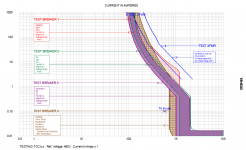PE (always learning)
Senior Member
- Location
- Saint Louis
- Occupation
- Professional Engineer
My twin brother and I are both electrical engineers and sometimes get into some fierce arguments when it comes to design.
Today we had an argument on primary breaker sizing for a 75 kVA transformer. The transformer was feeding a secondary 200 amp main circuit breaker panel at 120/208V, 3 phase, 4 wire and the primary was 480V, 3 phase and he used a 125 amp breaker (which is fine, but read on)
He told me that it is industry standard to size the overcurrent protection on the primary at 125 amps in this scenario to which I disagreed with. I told him that a 100 amp or even a 90 amp breaker would be fine in this scenario based on table 450.3(B). 450.3(B) clearly states that the 250% is a maximum overcurrent protection for transformers 1000 volts and less, but does not state minimum protection.
I know that having a higher primary breaker size is always nice in a scenario like this to avoid tripping from transformer inrush, but I have looked at the actual transformer inrush charts for many transformers and the real values are always well below the breaker trip curve values in the instantaneous region.
Again, I go back to his argument about using a 125 amp breaker as industry standard to which I say no. I say using a 100 amp breaker would be just fine and would probably save you money as usually going from 100 amps to a 125 amp breaker leads to using a sub fed breaker which costs more money.
Anyway, let me know your thoughts so we can know who wins.
Today we had an argument on primary breaker sizing for a 75 kVA transformer. The transformer was feeding a secondary 200 amp main circuit breaker panel at 120/208V, 3 phase, 4 wire and the primary was 480V, 3 phase and he used a 125 amp breaker (which is fine, but read on)
He told me that it is industry standard to size the overcurrent protection on the primary at 125 amps in this scenario to which I disagreed with. I told him that a 100 amp or even a 90 amp breaker would be fine in this scenario based on table 450.3(B). 450.3(B) clearly states that the 250% is a maximum overcurrent protection for transformers 1000 volts and less, but does not state minimum protection.
I know that having a higher primary breaker size is always nice in a scenario like this to avoid tripping from transformer inrush, but I have looked at the actual transformer inrush charts for many transformers and the real values are always well below the breaker trip curve values in the instantaneous region.
Again, I go back to his argument about using a 125 amp breaker as industry standard to which I say no. I say using a 100 amp breaker would be just fine and would probably save you money as usually going from 100 amps to a 125 amp breaker leads to using a sub fed breaker which costs more money.
Anyway, let me know your thoughts so we can know who wins.

